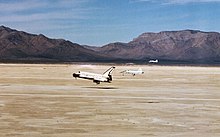Northrop T-38 Talon
The Northrop T-38 Talon is an American supersonic jet trainer. It was the world's first, and most produced supersonic trainer. It remains in service as of 2008 in air forces throughout the world including the USAF, which remains its largest user.
It is considered to have an exceptional safety record for a supersonic jet. The basic airframe was used for the light combat aircraft F-5 Freedom Fighter family. In addition to USAF pilots, T-38s are also used by NASA astronauts, other NATO pilots under a joint training program, and some under civilian ownership.
Design and development
The T-38 was designed in the mid 1950s as the trainer variant of a lightweight fighter project (the N-156 project) by the Northrop Corporation (today part of Northrop Grumman). Although the United States Air Force had no need for a small fighter at the time, it became interested in the trainer as a replacement for the T-33 Shooting Star it was then using in this role. The first of three prototypes (designated YT-38) flew on March 10 1959. The type was quickly adopted and the first production examples were delivered in 1961, officially entering service on March 17 that year, complementing the T-37 primary jet trainer. When production ended in 1972, 1,187 T-38s had been built. Since its introduction, it is estimated that some 50,000 military pilots have trained on this aircraft. The USAF remains one of the few armed flying forces using dedicated supersonic final trainers, as most such as the US Navy use high subsonic trainers.
The T-38 is of conventional configuration, with a small, low, long-chord wing, a single vertical stabilizer, and tricycle undercarriage. The aircraft seats a student pilot and instructor in tandem, and has intakes for its two turbojet engines at the wing roots. Its nimble performance has earned it the nickname white rocket—in 1962, T-38s set four climb records.
The F-5B and F (which also derive from the N-156) can be distinguished from the T-38 by the wings; the wing of the T-38 meets the fuselage straight and ends square, while the F-5 possesses leading edge extensions near the wing roots and wingtip launch rails for air to air missiles. Under the paint, the T-38 wing is constructed of honeycomb material whereas the wing of the F-5 family is constructed of conventional skin over underlying support structure.
Most T-38s built were of the T-38A variant, but the USAF also had a small number of aircraft that had been converted for weapons training. These aircraft (designated AT-38B) had been fitted with a gunsight and could carry a gunpod, rockets, or bombs on a centreline pylon. In 2003, 562 T-38s were still operational with the USAF and are currently undergoing structural and avionics programmes (T-38C) to extend their service life to 2020. Improvements include the addition of a HUD, GPS, INS (Inertial Navigation System), and TCAS as well as PMP (a propulsion modification designed to improve low-altitude engine performance by significantly increasing thrust). Many USAF variants (T-38A and AT-38B) are being converted to the T-38C standard.

The USAF Strategic Air Command had T-38 Talons in service from 1981 through 1991. These planes were used to enhance the career development of bomber co-pilots through the "Accelerated Copilot Enrichment Program."
Besides the USAF, other T-38 operators include the German Luftwaffe, the Portuguese Air Force, the Republic of China Air Force, the Turkish Air Force and the US Navy. It is also flown by NASA and Boeing, who use the type as a chase plane. NASA also uses the plane as a jet trainer for its astronauts; its fleet is housed primarily at Ellington Field in Houston, Texas, though there were some notable fatal accidents in the 1960s.[clarification needed] There is also a very small number of them in private civilian hands.
The fighter version of the N-156 was eventually selected for the US Military Assistance Program (MAP) and produced as the F-5 Freedom Fighter. Many of these have since reverted to a weapons training role as various air forces have introduced newer types into service. The F-5G was later developed into the single-engine F-20 Tigershark.
In response to the 1973 OPEC oil embargo, the Thunderbirds aerobatic display team of the U.S. Air Force adopted the T-38 Talon in 1974 which used far less fuel than the F-4 Phantom. (The Blue Angels downsized to the A-4 Skyhawk at roughly the same time). After the infamous "Diamond Crash" incident that killed four of the team's six demonstration pilots, the Talon was replaced in this role by the front-line F-16A Fighting Falcon in 1983.
Variants

- N-156T : Northrop company designation.
- YT-38 : Prototype, two built, later re-designated YT-38A
- T-38A : Two-seat advanced training aircraft, production model, 1139 built.
- T-38A(N) : Two-seat astronaut training version for NASA.
- AT-38A : A small number of T-38As were converted into weapons training aircraft.
- DT-38A : A number of US Navy T-38As were converted into drone directors.
- NT-38A : A small number of T-38As were converted into research and test aircraft.
- QT-38A : Unmanned target drone aircraft.
- AT-38B : Two-seat weapons training aircraft.
- T-38C : A T-38A with structural and avionics upgrades. [1]
Operators
- United States Air Force
- United States Navy
- NASA (~32 aircraft)
- Thornton Aircraft Company (~5 aircraft)
- Boeing (~1 aircraft)
Specifications (T-38A)
General characteristics
- Crew: 2: student and instructor
Performance
- Thrust/weight: 0.65
See also
Related development
Related lists
